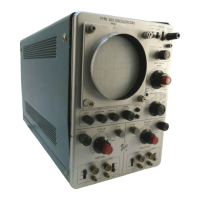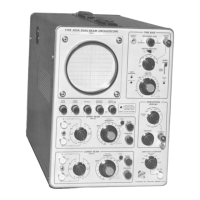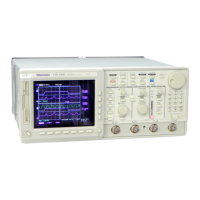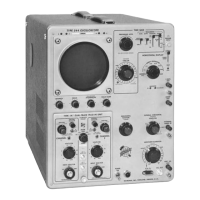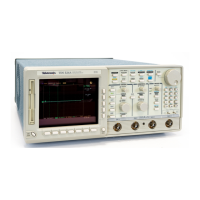INITIAL PROCEDURES
As mentioned previously, the first checks that
should be made in the event of an apparent
trouble are for proper control settings and cor
rect calibration. The next check for any type of
trouble should be for proper operation of the
regulated power supplies. Correct operation of
every circuit in the oscilloscope depends on pro
per output voltages from the regulated power
supplies. Due to the circuit configuration em
ployed in the Type 502, it is possible for an in
correct power supply voltage to affect one circuit
more than the others. When all but one circuit
in the oscilloscope is functioning properly, there
is a tendency to overlook the power supply as a
source of the trouble and to concentrate on the
circuit where the trouble apparently exists. In
cases of this type, valuable time can be saved
by checking the power supplies first. If the out
put and ripple voltages of the regulated power
supplies are correct, use the trouble symptoms
and the following Circuit Isolation information to
locate the defective circuit.
WARNING
Be careful of power supply voltages.
Under certain conditions, they can
be dangerous to human life. O ut
puts of the Low Voltage Power Sup
ply are particularly dangerous due
to their high current capabilities.
When working on the instrument with the
power on, you should work with only one hand
at a time, being careful that the other hand does
not touch the metal frame of the instrument. If
possible, stand on an insulated surface, and use
insulated tools and probes.
PART 1: CIRCUIT ISOLATION
This portion of the Troubleshooting Procedure
lists most of the troubles that can be caused by
a circuit failure in the Type 502 Oscilloscope. It
also describes checks that can be made to isolate
the faulty circuit or circuits. In some cases,
simple front panel checks can determine which
circuit is defective, but in other cases internal
checks and/or measurements are required.
The following troubleshooting information is
subdivided according to the various types of
troubles. Upon detecting an apparent trouble,
you can use the symptoms of this trouble to lo
cate the proper subdivision. After determining
which circuit is at fault, you can then refer to
Part II, where the procedure for troubleshooting
within the circuit is given.
Either the Upper or Lower Beam Not Visible
On CRT
The inability to display either the upper or
lower beam on the face of the crt may be due to
an unbalance in the corresponding vertical am
plifier or to a defect in the crt circuit.
To determine which circuit is at fault, short
Fig. 5-3. Checking for unbalance in the upper beam
vertical amplifier by shorting the vertical deflection
plates together.
the applicable vertical deflection plates together
at the neck of the crt. Be careful that the pins
are not shorted to the crt shield. If the beam re
turns to the crt face, the trouble is due to an un
balanced vertical amplifier. If the beam does
not reappear, the trouble is located in the crt
circuit.
®
MAINTENANCE — TYPE 502
5-5
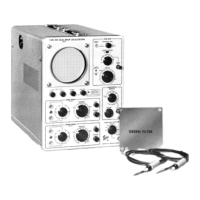
